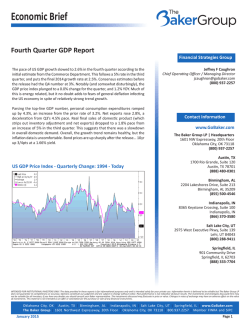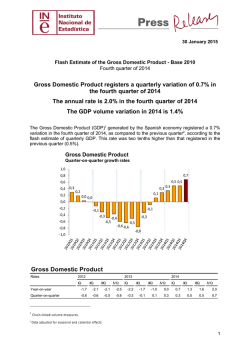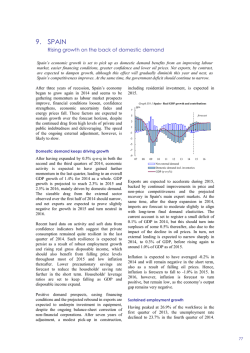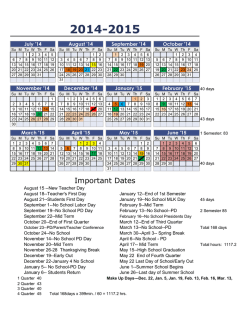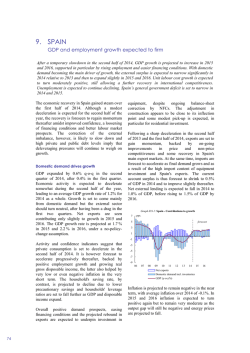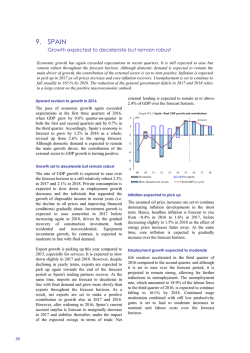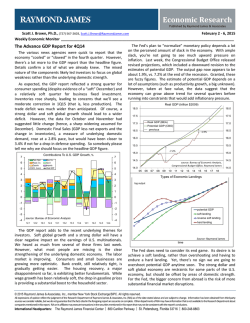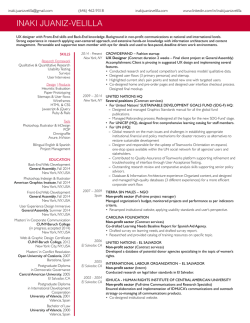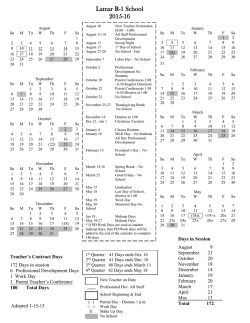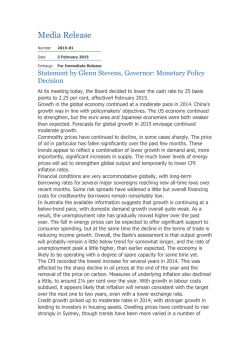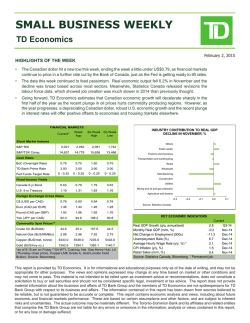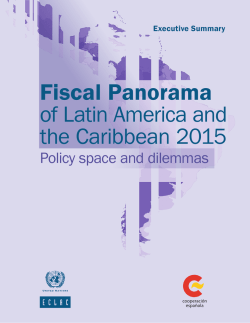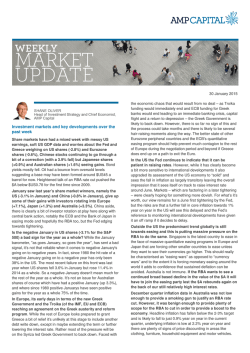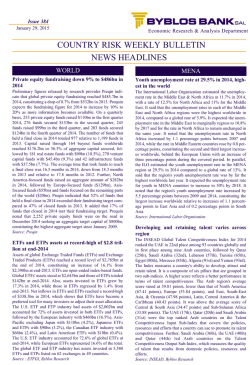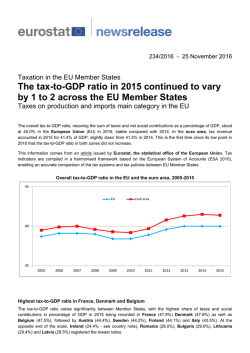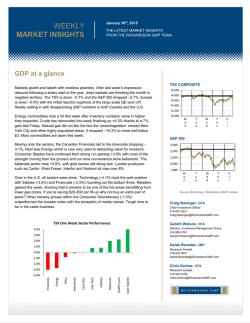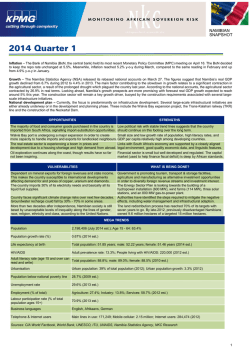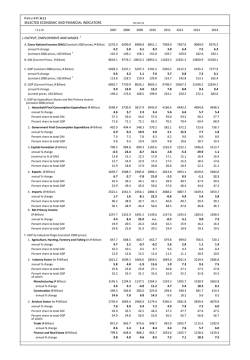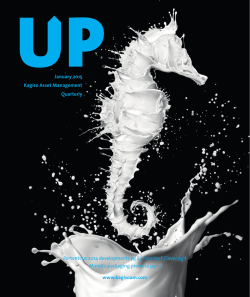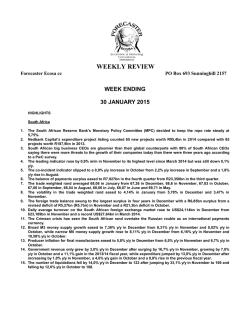
El Salvador_en - Repositorio CEPAL
Preliminary Overview of the Economies of Latin America and the Caribbean ▪ 2014 1 El Salvador After a hard-fought election, on 1 June Salvador Sánchez Cerén, the candidate of the Farabundo Martí National Liberation Front, took office as President. The two main challenges of his time in office will be, firstly, revitalizing an economy that grew at an average annual rate of just 1.8% from 2010 to 2013 (and will expand by 2.2% in 2014 and 2.5% in 2015, according to ECLAC projections) and, secondly, bringing down large deficits in the public finances and the current account, which official forecasts for 2014 put at levels slightly lower than the 4% and 6.5% of GDP, respectively, posted in 2013. As has been the case for several years, fiscal policy in 2014 was preoccupied with striking a balance between the need for spending and investment, principally associated with social policy, and the sustainability of the public finances. It was in this context that a raft of tax reforms were adopted in August, including the introduction of the financial transaction debit tax and the tax on non-productive luxury properties, a change to the minimum income tax contribution, the removal of an income tax exemption for owners of print works and various amendments to the tax code. According to official estimates, the tax burden should rise by around 0.8% of GDP in 2015 on the back of the reform, so that it should yield more than the 0.60% of GDP raised by the reforms of 2010 and 2011. Reversing the growth trend observed since 2010, income in the non-financial public sector (NFPS) expanded by only 0.1% in real terms in the first nine months of 2014 compared to the same period in 2013. This was attributable to a contraction of 1.1% in the tax take, which had been equivalent to 15.4% of GDP at the end of 2013, since growth of just 0.5% in income tax receipts was too little to offset a fall of 1.7% in value added tax revenue resulting from a slowdown in consumption from the third quarter onward. Austerity measures imposed on public spending were a contributing factor in a slight contraction (-0.1%) in current spending and a drop of 16% in capital expenditure. Consequently, spending by the NFPS was down by 2.4% in real terms up to the third quarter, in contrast to the 7.3% expansion in the same period of 2013. As a result, the NFPS deficit narrowed by almost 25% in real terms to September. Official projections put the fiscal deficit, including the cost of pensions and trust funds, at 3.9% of GDP, slightly below the 4% recorded in 2013. 6 3 5 4 2 3 2 1 1 0 Q1 Q2 Q3 Q4 Q1 Q2 2012 Q3 Q4 2013 GDP Q1 Q2 Q3 Inflation, 12-month variation In the financial sphere, six-month deposit rates held steady at around 2.5% over the first nine months of 2014, leading to nominal growth of 1.6% in the M2 monetary aggregate. Over the same period, when the uncertainty associated with the legislative and presidential elections had cleared up, rates on loans of up to one year declined by around half a percentage point from the real-terms level of 5% El Salvador: GDP and Inflation, 2012-2014 GDP, four-quarter variation By contrast with 2013, when the budget shortfall was chiefly financed by selling short-term bonds on the domestic market, in 2014 debt accrued by issuing Treasury bills was replaced by a 12-year global bond worth US$ 800 million with a yield of 6.4%, half a percentage point above that of a similar bond sold in late 2012. 0 2014 Inflation Source: Economic Commission for Latin America and the Caribbean (ECLAC), on the basis of official figures. 2 Economic Commission for Latin America and the Caribbean (ECLAC) recorded at the end of 2013. Consequently, bank lending to the private sector, which had grown by 5.7% in real terms to September 2013, rose by 6.4% over the same period of 2014. Exports of goods contracted by 4.6% up to the third quarter of 2014 —reversing growth of 3.9% in the same period of 2013— owing to a fall in exports of coffee, since production has yet to recover from the impact of coffee-leaf rust. This was compounded by a drop of 7.9% in maquila exports, partly representing a fall-off from the particularly high values seen in 2013, when exports grew by 8.7% to the third quarter, and partly resulting from lower demand for textiles from the United States, which could be a symptom of a loss of competitiveness vis-à-vis exports from other Central American producers. Imports of goods, meanwhile, were down 2.9% in nominal terms, a far cry from the growth of 5.7% posted during the same period of 2013. The fall in imports by value is chiefly attributable to the effect of lower hydrocarbon prices on the oil bill, which contracted by 13.6% to the third quarter of 2014. El Salvador: main economic indicators, 2012-2014 Gross domestic product Per capita gross domestic product Consumer prices Real average wage c Money (M1) Real effective exchange rate e Terms of trade Open urban unemployment rate Central government Overall balance / GDP Nominal deposit rate Nominal lending rate f Exports of goods and services Imports of goods and services Current account balance Capital and financial balance g Overall balance 2012 2013 2014 Annual growth rate 1.9 1.7 2.2 1.3 1.1 1.6 0.8 0.8 1.7 0.2 0.5 … 4.4 2.9 4.2 -0.6 0.6 0.4 -3.4 -0.4 3.5 Annual average percentage 6.2 5.6 ... -1.7 -1.8 2.5 3.4 5.6 5.7 Millions of dollars 6,094 6,403 10,513 11,113 -1,288 -1,577 1,939 1,250 651 -327 … 3.7 6.0 a b d b d d 6,349 10,828 -1,030 1,279 248 Source: Economic Commission for Latin America and the Caribbean (ECLAC), on the basis of official figures. a/ Estimates. b/ Figures as of September. c/ Average taxable wage. d/ Figures as of Octubre. e/ A negative rate indicates an appreciation of the currency in real terms. f/ Basic lending rate for up to one year. g/ Includes errors and omissions. The overall result was a nominal reduction of 1% in the trade deficit. Remittance flows expanded by 8% in nominal terms to September, which compares favourably with the muted growth of 1.3% in the same period of 2013. El Salvador’s economy grew at a rate of 2% in the first half of 2014, half a percentage point higher than in the same period of 2013. This slight acceleration was driven by growth of 1.7% in agriculture and 2.6% in commercial activity, the latter spurred by buoyant remittance receipts. The recovery in agriculture, however, was principally a reflection of the weakness of the previous year’s results, since coffee production remains affected by coffee-leaf rust and that of basic grains by drought. Monthly indicators of economic activity point to a slowdown in the third quarter of 2014, attributable to a continuing contraction in construction together with a loss of momentum in manufacturing and commerce. Given the growth of remittances, this slower pace of activity may reflect more cautious behaviour by households in the wake of rising violence between gangs. Nonetheless, the authorities are projecting growth of 2.2% for 2014 as a whole in view of the launch of a number of investment projects, particularly those associated with the second phase of the Millennium Fund (FOMILENIO) project, financed out of United States cooperation resources intended for the development of the country’s coastal marine area. Cumulative 2014 inflation to October was 1.8%, more than 1 percentage point higher than in the same period the previous year. This increase occurred primarily because food prices were pushed up by the relative scarcity of basic grains owing to the drought, something lower fuel prices were insufficient to offset. The official projection for December-to-December inflation in 2014 is 1.9%. Preliminary Overview of the Economies of Latin America and the Caribbean ▪ 2014 3 Where employment is concerned, data on contributors to the Salvadoran Social Security Institute point to a slowdown in formal job creation, with growth to September averaging 2.7% , well below the 4.5% seen in the same period of 2013. The greatest fall-off in new job growth was in manufacturing and, to a lesser extent, commerce.
© Copyright 2024
